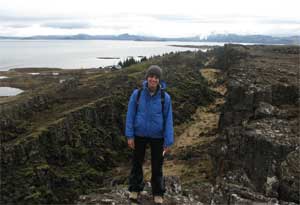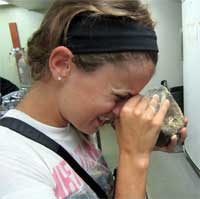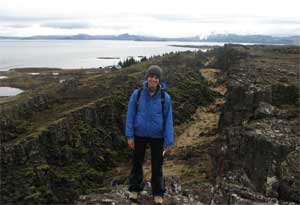 NARRAGANSETT, R.I. – March 11, 2013 – Maryjo Brounce, a doctoral student at the University of Rhode Island’s Graduate School of Oceanography, has been recognized with awards for the best student presentation and the outstanding student research paper in the field of tectonophysics at the recent meeting of the American Geophysical Union, the largest gathering of earth and space scientists in the world.
NARRAGANSETT, R.I. – March 11, 2013 – Maryjo Brounce, a doctoral student at the University of Rhode Island’s Graduate School of Oceanography, has been recognized with awards for the best student presentation and the outstanding student research paper in the field of tectonophysics at the recent meeting of the American Geophysical Union, the largest gathering of earth and space scientists in the world.
Brounce, a native of Philadelphia who earned a bachelor’s degree in geosciences and a minor in chemistry from Pennsylvania State University, credits advice from her faculty mentors, Katherine Kelley and Elizabeth Cottrell, for her award winning presentation.
“They told me to make sure the language in my presentation was professional and clear, and that advice was very helpful for me,” said Brounce. “What I do is really exciting research, so if you’re able to communicate it clearly, it’s easy to get other people excited about it.”
 Brounce studies the lava, ash and minerals that erupt from undersea volcanoes at subduction zones, sites where Earth’s tectonic plates are pushing together, forcing one plate beneath the other. By studying the chemical composition of the erupting material, she can determine where the material came from.
Brounce studies the lava, ash and minerals that erupt from undersea volcanoes at subduction zones, sites where Earth’s tectonic plates are pushing together, forcing one plate beneath the other. By studying the chemical composition of the erupting material, she can determine where the material came from.
“I’m trying to understand how oxygen gets recycled in subduction zones, how oxygen is taken inside the Earth,” Brounce explained. “If we’re taking oxygen out of the atmosphere and returning it to the inside of the Earth, does it come back out? Is there a constant draw down of oxygen through time, or does it come back out through volcanoes? I think it does.”
Her presentation at the conference summarized how she traces the movement of oxygen into the Earth and back out again by assessing the oxidation state of rocks that have erupted from volcanoes.
“I studied a bunch of lava rocks from the Mariana Islands, south of Japan, to understand their iron concentrations and how much of that iron is oxidized iron,” Brounce said. “I used that information to look through the volcano and understand the oxygen content of the mantle, how much oxygen is available there. I found that the oxygen content is higher than normal, and I was able to link it to the plate sinking at the subduction zone, cycling oxygen down through the subduction zone.”
The paper she presented at the conference is one chapter of her doctoral dissertation, which she expects to complete next year. After graduation, she hopes to continue conducting research as a university professor.
“There’s no use in finding out all of this interesting stuff if you can’t teach others about it,” she said.
“This is important research because we walk around on the surface of the Earth and we know about the rocks at our feet and about the composition of the atmosphere, but all of those things are supplied to us from volcanoes,” added Brounce. “All of the things that have been coming out of volcanoes for 4 billion years have created what we have on the surface of our Earth. Volcanoes control the composition of the soils we grow crops in and the gasses that we breathe. It’s important that we understand that process.”
Pictured above
Maryjo Brounce poses at a geologic formation in Iceland.
URI graduate student Maryjo Brounce takes a close-up look at a lava rock in her laboratory at the Graduate School of Oceanography.
Photos by Maryjo Brounce

